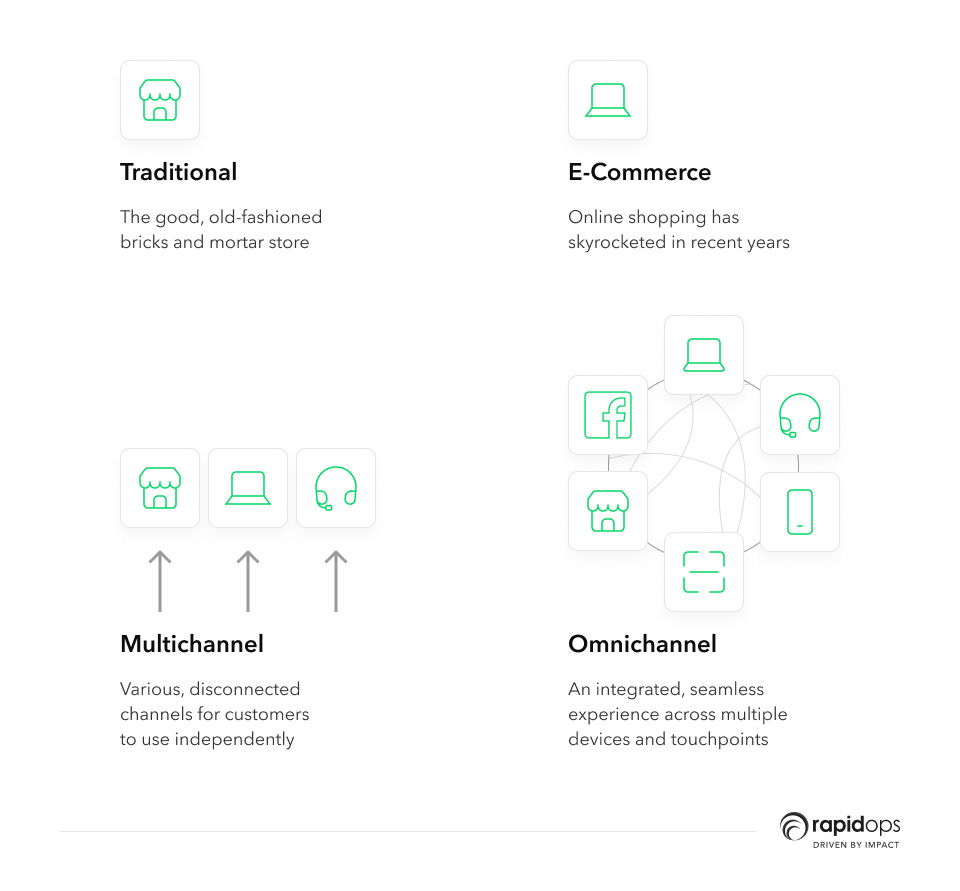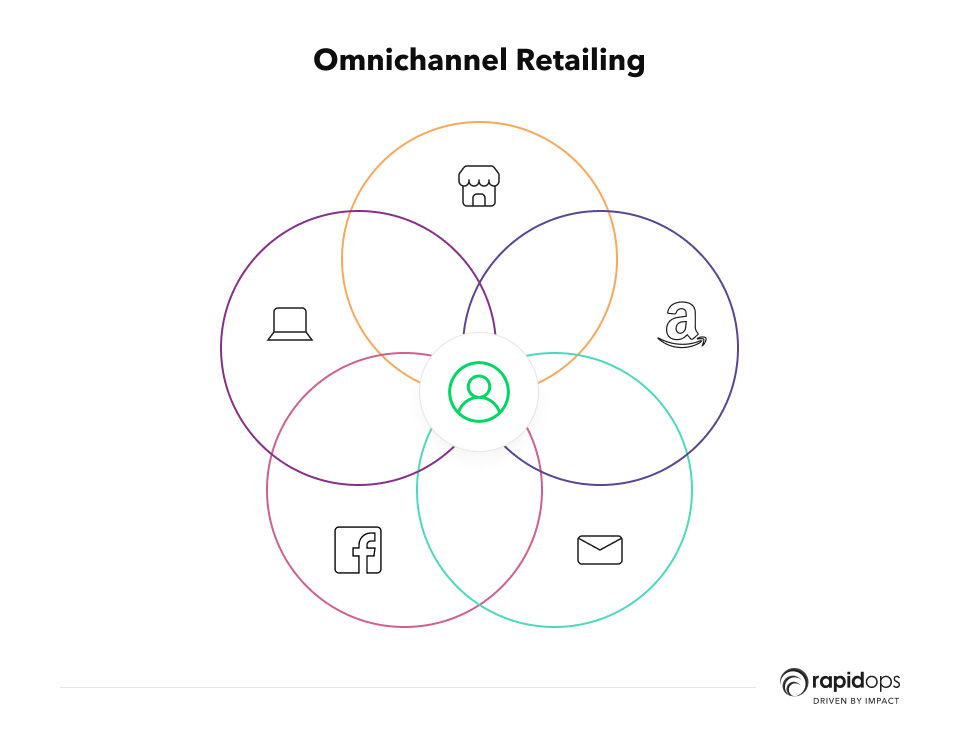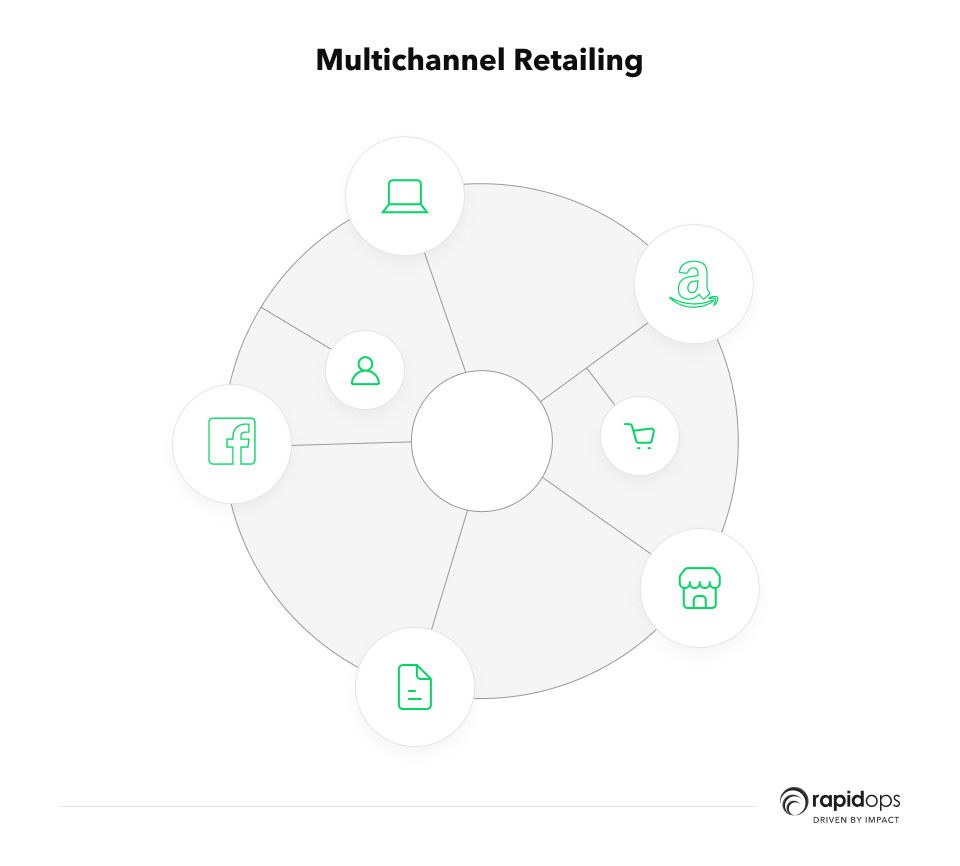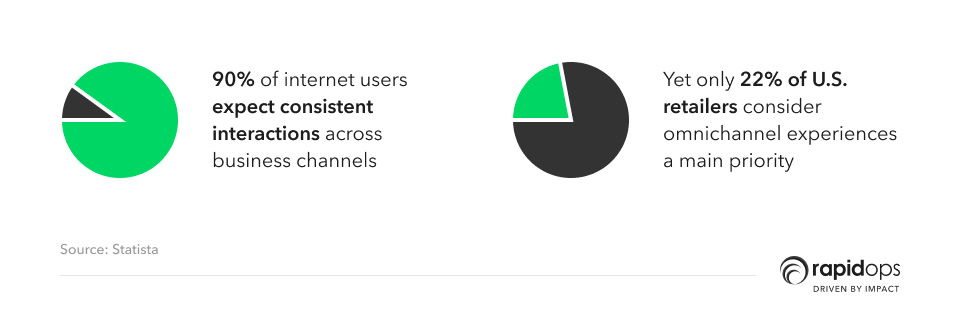If you are in the retail industry, you already know that the competition is punitive. Retail market leaders are looking for better revenue by converting shoppers into customers. The purpose can be fulfilled by creating a loyal customer base. With the digital wave sweeping the retail industry, retailers want to be a market leader by redesigning the customer experience across the business’s channels.
“Today’s customer journey is so complex that it looks more like the plot of a “whodunit” than a decision to buy a new jacket. Consumers have more choices than ever before. They research and shop across multiple devices, multiple touchpoints, around the clock — both online and off.” – Think With Google
Modern customers want brand interaction and engagement
- In person
- Over the phone
- On the website
- Via social channels
- Across other mobile apps and website
They also want the process to be seamless and interactive across different platforms. Disruptive retailers should access their current operational structure and derive the below questions.
- How omnichannel retailing is becoming an integrated approach for retailers?
- How can retailers provide a unified experience to customers across various touchpoints?
This article on omnichannel retailing will comprehensively cover
- The need for omnichannel retail
- The meaning of omnichannel in retail
- Omnichannel vs. Multichannel retailing
- Omnichannel retail challenges
- The omnichannel retail strategy
Why do incumbents need to shift towards Omnichannel retail?
75% of shoppers use multiple channels for comparing prices and seeking the best deals. Shoppers also use apps for the same purpose; even while they are in-store.
Retailers must streamline their customer touchpoints and strategies for a seamless customer experience. Let us take an overview of the omnichannel customer experience.
A customer discovers you online. He/she purchases either from the official website or third-party websites. They receive a tailored-for-buying platform unboxing experience. This experience includes pamphlets of website-exclusive products along with
- A discount
- Information on a loyalty program
- Retail experiences (i.e., store or popup)
- URL to a dedicated “fill-up form” on your site
Your landing page triggers tracking codes. These are used for retargeting customers and visitors with ads. The ads are related to complementary products to their original purchase.
When the customers make a second purchase, they get an email notification of a nearby store offer. Before running new campaigns, loyal customers receive tailored products collection links. Or get invited to a members-only VIP lounge via social media channel or email.
What does omnichannel mean in retail?

Retailers fail to provide a unified experience to their customers across the channels. Most of them cannot offer a faster omnichannel experience to their customers.
Omnichannel retailing requires thorough integration of customer touchpoints and channels. It also needs a system that gathers customer data from these touchpoints. Using the data retailers can offer customers what they need, at any point or on any device!
Back in 2003, Best Buy made a revolutionary move in the retail sector. They took a customer-centric approach. Under this approach, the brand created an opportunity for the customers to access everything in real-time.
Omnichannel vs multichannel retailing – The difference
By taking one look at these two individual words, you will think that they mean the same. But they functionally differ from each other. Let us dive deeper and see their functional difference.
What is Omnichannel retailing?

Omnichannel retail is an immersive way of doing business where the customer is at the center of every strategy. Here, the communications take place across channels before the end purchase. Retailers remove data silos and unify their channels. This creates an integrated system aware of the customer's presence in individual channels. Omnichannel retail helps create a seamless customer experience with every data stored in a centralized hub.
What is Multichannel retailing?

Multichannel is the method of presenting varied options of engaging and purchasing with your brand to the customers. Your brand is the focal point in this retail model where each channel act as individual silos.
Challenges to overcome in omnichannel retailing
Customers begin their journey on one channel and complete it on another. Customers can place an order, and get it delivered to their doorstep or do a curbside pickup. Most important is the transition. It must be so smooth that customers must never realize they have switched channels.
Although this idea seems enticing. As enticing as this practice may be, it does not come easy or without any challenges. So, let us talk about the challenges and see how we can overcome them.
1. Distorted in-store and online stock allocation
With an all-in-one approach, one retailer cannot accomplish successful omnichannel retail. The sale of a product at brick-and-mortar stores might eat its way into online sales in case of low inventory. Here are some of the ways to counteract this challenge:
- Reducing inventory availability of fast-moving products on online channels
- Keep a steady product supply through timely orders from vendors
- Carry out warehouse pick-ups and product packing before peak hours
- Deploy “dark stores” with minimal walk-in traffic
- Create high order for fast-moving inventory items and high-frequency, multi-channel sales
2. Duplication of stock
Over-ordering of stock due to sale overestimation is problematic for retailers. Inventory mismanagement also causes stock duplication. Both these scenarios block a retailer’s working capital.
Retailers must take inventory management optimization as their top priority. This is crucial while adopting omnichannel retail on a fixed budget.
Replenishing fast-moving inventory helps in sustaining your working capital. With an inventory management system, retailers can worry less about mismanaging their stock.
3. Achieving flawless inventory management
Under omnichannel retailing, products are listed and sold across channels. These channels must have the same control and distribution system. To curb mishaps, inventory management and allocation must be prioritized for the most active channels. The downside of this move is that less frequent channels have an elevated risk of missing orders.
A typical supply-demand gap proves costly in terms of losing loyal customers. Retailers must prioritize inventory management and make the most of inventory visibility. They must streamline order handling for faster customer requirement fulfillment.
Retailers must keep SKU codes consistent and recognizable across the channel. Also, the barcodes must be unique and straightforward across SKUs. This way, their inventory management will become smooth and without hiccups.
4. Misalignment of technology
On applying omnichannel retailing, existing technology infrastructure and processes become obsolete. They need to rethink their channels and processes to make technology work for them. This way, retailers can smoothen their operations and analyze individual channel performance. Retailers must harness automation technology for mitigating omnichannel retail challenges.
Omnichannel retail uses technology to tie all channels together. This creates a unified shopping experience across devices and channels.
Technology is blurring the line between online and offline channels. Target is the perfect example of fusing technology.
A shopper can check the nearest in-store stock by logging into Target’s mobile app in real-time. Once the order is placed via the app, they can pick it up from the store the same day. This seamless purchasing process cuts out the frictions involved in walk-in sales. It also proves to be a quick purchasing option that makes the customers happy!
Creating your omnichannel retail strategy

“In omnichannel, every customer interaction changes their overall experience of your product and brand.”
An omnichannel retail strategy is a disruptive approach for sales and marketing. It helps retailers create a merged shopping experience that unites across channels.
4-Step omnichannel strategy for your retail business
Retailers may need diverse omnichannel strategies for their operational processes as one size does not fit all. Yes, it is retail after all, yet the strategy, processes, and technological architecture might differ from one retailer to the other. The budget also plays a very crucial role when it comes to deploying omnichannel retail strategy.
You will also need to analyze carefully
- Your goals
- Your capabilities
- Your company cultures
Then, you can take the help of these steps below to craft your strategy.
Step 1: Connecting online and physical channels
For this, you must identify your sales and customer engagement channels. Product descriptions and pricing must be consistent across channels. Any actions taken in one channel should reflect in others.
For instance-
A product is sold out on your brick-and-mortar store. The other channels must also reflect this information. When there is an inconsistency, it could lead to mistrust from customers.
Step 2: Building a flexible business model
Retailers need to generate customer trust for their brand's success. Providing a great customer experience is the way to do that. Omnichannel retailing helps retailers by
- Keeping customers engaged
- Enticing them with offers to spend more
- Creating a loyal customer base
By centralizing the channels, retailers gain more control over them. This creates more opportunities and pivots faster sales. You must invest in a future-proof e-retailing solution early on as it enables you to expand into new channels.
Step 3: Share data across channels
In-depth analysis of customer journey helps in maintaining an omnichannel retail experience. An integrated customer data platform collects and analyzes customer journeys across sales channels.
A customer relationship management system helps in tracking customer interaction across channels. You can automate processes and experiences based on the data collected by the CRM system.
Centralizing and controlling data centrally helps add efficiency to the retail process. You get better visibility over customer activity across channels and with that data you can personalize the experience for gaining trust and loyalty.
The adopted analytical tools must provide complete insight into customer needs and inventory. This way, the needs can be fulfilled at the right time and on the right channel.
Step 4: Personalizing the customer experience across channels
As mentioned above, customer data hold critical value in personalizing the customer experience. CRM systems can allow retailers to keep track of customer journeys across channels. This helps in tailoring offers, discounts, and assorted services.
Technology has already enabled tracking consumer behavior across channels. You can know what products customers look for, which products are on their Wishlist, their most frequent purchases, and the mode. Once you get insights into consumer behavior, it gets easier to craft the desired customer experience.
Concluding thoughts: Retailers need digital disruption to create a unified customer experience
Omnichannel retail does not compel retail owners to be anywhere, and they need to be present everywhere their customers are! Many retail brands still only plan to provide a unified experience to their customers across the channels.
True omnichannel retailing goes beyond traditional brick-and-mortar locations. It takes shoppers through mobile browsing, online markets, brand social pages, etc., towards the final purchase.
Numerous retail businesses have transitioned to omnichannel selling. Many still stay aloof from the same. If you are still pondering over the idea of transitioning into omnichannel retail, then you are at the right place.
Rapidops has worked with established retail brands in the past 10+ years. It understands the technological requirements of digitally transforming a legacy business process. As a technology consultant, it guides retail owners to take the best way towards digitally-driven growth.
Do you want an expert opinion on launching the next big thing in the retail market? Are you looking to translate your vision, challenges, and ideas into a market-leading digital product? Do you want to monetize your digital opportunities? If yes, then let's have a chat soon!
RETAIL
A fresh take on online grocery shopping
How we helped one of the largest grocery chains transform grocery shopping experience?

What’s Inside
- Why do incumbents need to shift towards Omnichannel retail?
- What does omnichannel mean in retail?
- What is Omnichannel retailing?
- What is Multichannel retailing?
- Challenges to overcome in omnichannel retailing
- Creating your omnichannel retail strategy
- Concluding thoughts: Retailers need digital disruption to create a unified customer experience
- A fresh take on online grocery shopping

Let’s build the next big thing!
Share your ideas and vision with us to explore your digital opportunities
Similar Stories
- Strategy
- undefined Mins
- February 2017

- Transformation
- undefined Mins
- March 2022


Receive articles like this in your mailbox
Sign up to get weekly insights & inspiration in your inbox.

